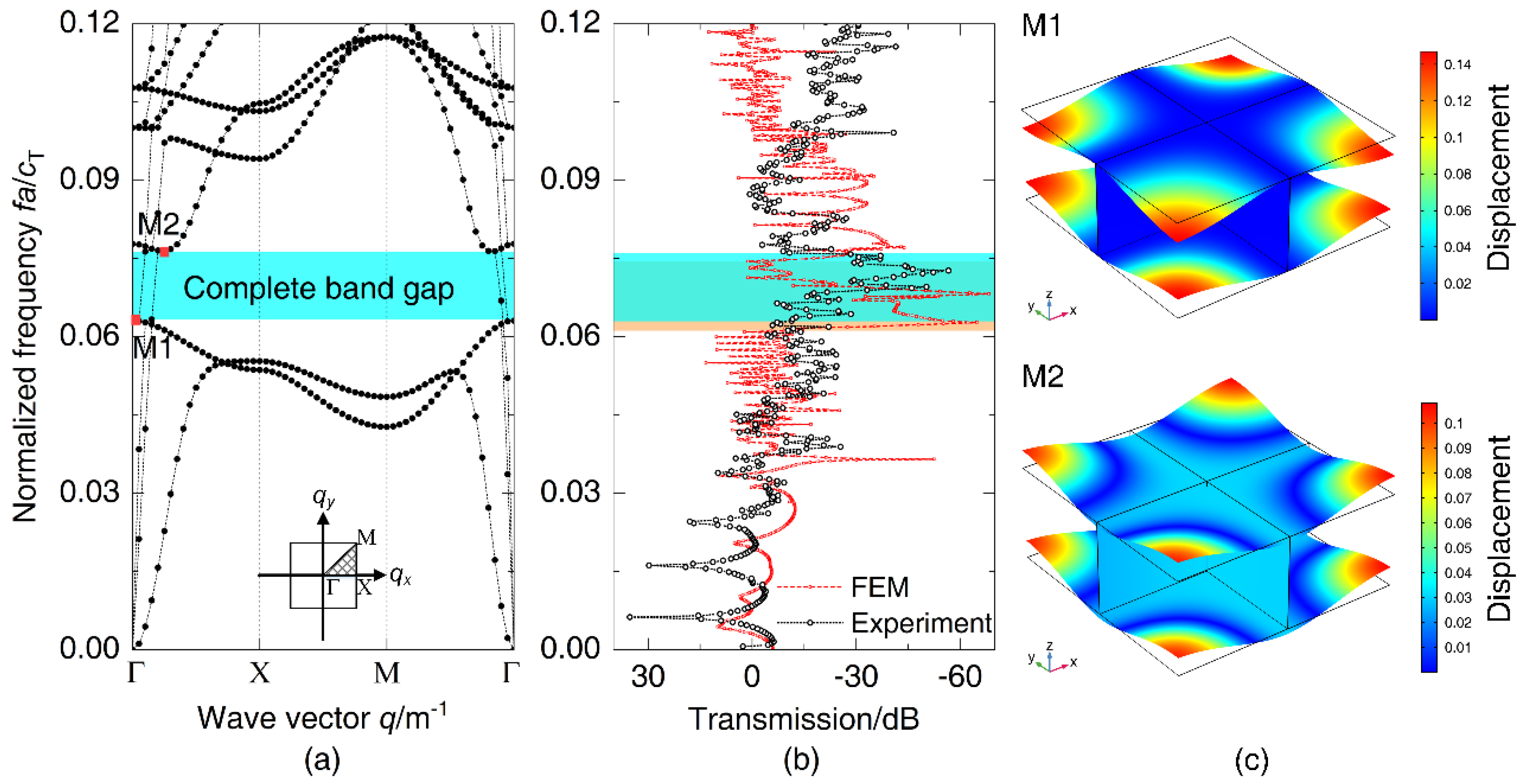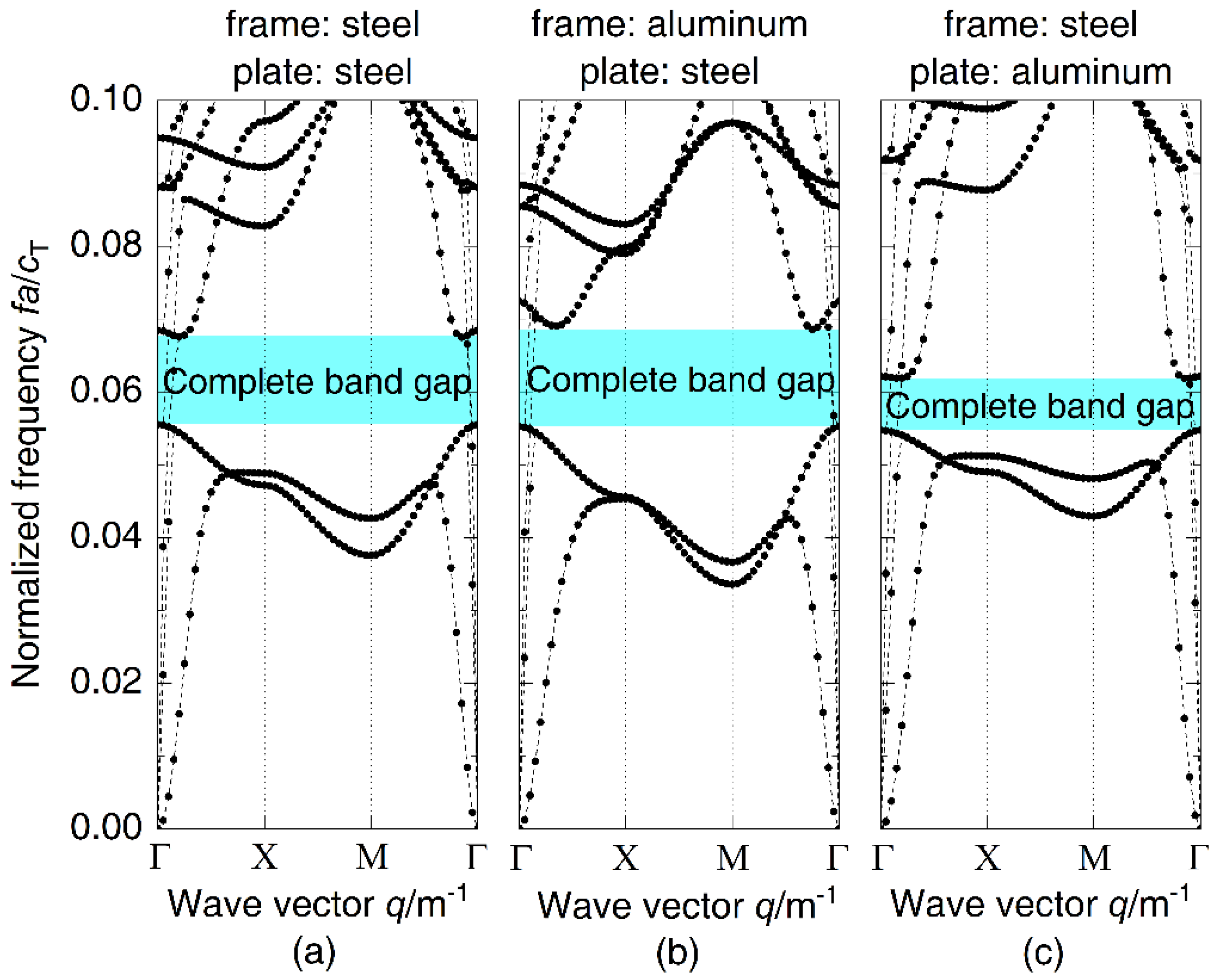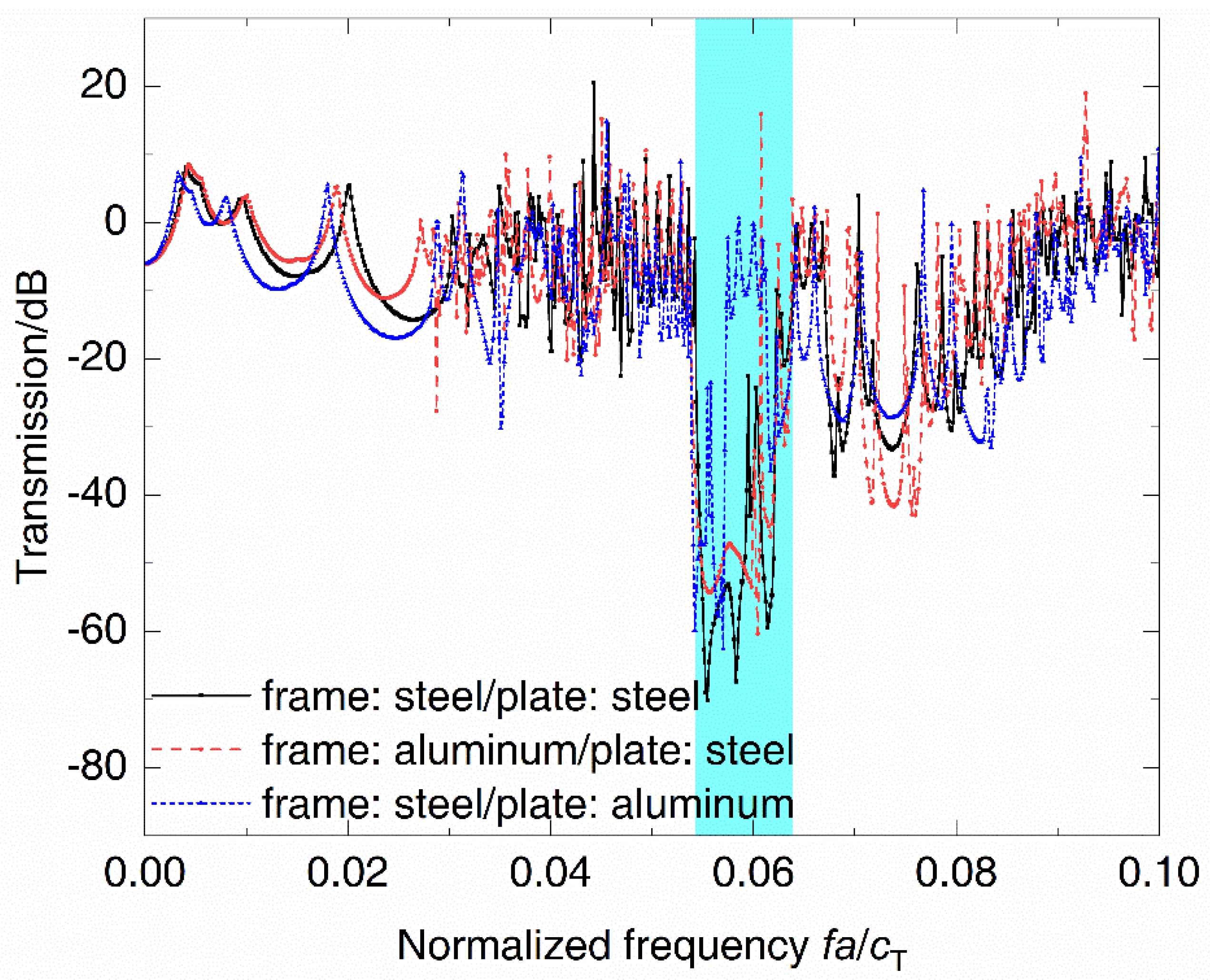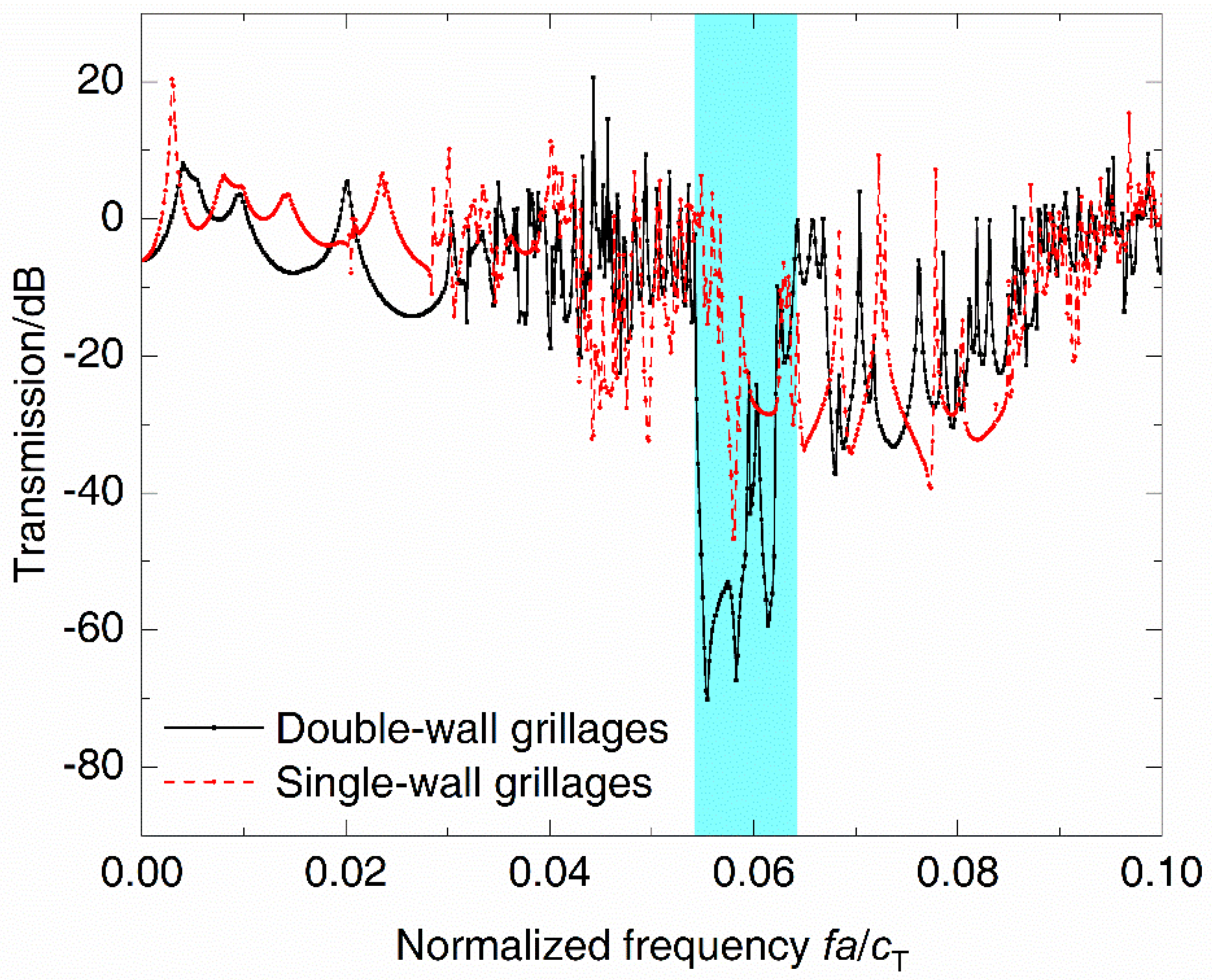Vibration Band Gap Characteristics of Two-Dimensional Periodic Double-Wall Grillages
Abstract
:1. Introduction
2. Materials and Methods
3. Results and Discussion
3.1. Numerical Calculation and Experimental Verification
3.2. Analysis of Influencing Factors
4. Conclusions
- There is a complete band gap in the periodic DwGs, which can be calculated accurately by the WFEM. The dispersion relations of numerical results are compared with the vibration transmission spectra of the model test and finite element calculation, which proves the effectiveness of the method in calculating the vibration band gap of DwGs.
- The complete band gap of periodic grillage structures is mainly related to the shear deformation of plates, and therefore material parameters of the plate have more influence on the band gap than the frame, which always works as the foundation of a DwG.
- With an increase in the dimensionless elastic modulus and thickness of plates, the band gap gradually moves to a higher frequency; in contrast, when the dimensionless density of plates gradually increases, the band gap moves to a lower frequency. All the bandwidths first increase and then decrease, and reach the maximum value when the dimensionless parameters equal certain values.
- Compared with DwGs, SwGs show shear deformation characteristics of the frames due to the lack of plates at the bottom, resulting in the decrease of the bandwidth, which causes the attenuation effect to decrease.
- The frame forms of DwGs have a direct impact on the band gap characteristics. The transverse-framed DwGs in this article produce an additional directional band gap after the complete one, which leads to a wider bandwidth and a smaller attenuation in this frequency range than the longitudinal-framed DwGs.
Author Contributions
Funding
Data Availability Statement
Conflicts of Interest
References
- Hoppman, H.W.; Huffington, N.J.; Magness, L.S. A study of orthogonally stiffened plates. J. Appl. Mech.-Trans. ASME 1956, 23, 343–350. [Google Scholar] [CrossRef]
- Sundara Raja Iyengar, K.T.; Jagadish, K.S. Vibration of rectangular orthotropic plates. Appl. Sci. Res. 1964, 13, 37–42. [Google Scholar] [CrossRef]
- Rao, D.V.; Sheikh, A.; Mukhopadhyay, M. A finite element large displacement analysis of stiffened plates. Comput. Struct. 1993, 47, 987–993. [Google Scholar] [CrossRef]
- Alinia, M.M. A study into optimization of stiffeners in plates subjected to shear loading. Thin-Walled Struct. 2005, 43, 845–860. [Google Scholar] [CrossRef]
- Hughes, O.F. Ship Structural Design: A Rationally-Based, Computer-Aided, Optimization Approach; Wiley-Interscience: New York, NY, USA, 1983. [Google Scholar]
- Legault, J.; Atalla, N. Numerical and experimental investigation of the effect of structural links on the sound transmission of a lightweight double panel structure. J. Sound Vib. 2009, 324, 712–732. [Google Scholar] [CrossRef]
- Shen, C.; Xin, F.X.; Lu, T.J. Sound transmission across composite laminate sandwiches: Influence of orthogonal stiffeners and laminate layup. Compos. Struct. 2016, 143, 310–316. [Google Scholar] [CrossRef]
- Fu, T.; Chen, Z.B.; Yu, D.; Wang, X.Y.; Lu, W.X. Sound transmission from stiffened double laminated composite plates. Wave Motion 2017, 72, 331–341. [Google Scholar] [CrossRef]
- Huang, K.-X.; Shui, G.-S.; Wang, Y.-Z.; Wang, Y.-S. Meta-arrest of a fast propagating crack in elastic wave metamaterials with local resonators. Mech. Mater. 2020, 148, 103497. [Google Scholar] [CrossRef]
- Brillouin, L. Wave Propagation in Periodic Structures, 2nd ed.; Dover Publications: New York, NY, USA, 1953. [Google Scholar]
- Mead, D.J. Wave propagation and natural modes in periodic systems: I. Mono-coupled systems. J. Sound Vib. 1975, 40, 1–18. [Google Scholar] [CrossRef]
- Mead, D.J. Wave propagation and natural modes in periodic systems: II. Multi-coupled systems, with and without damping. J. Sound Vib. 1975, 40, 19–39. [Google Scholar] [CrossRef]
- Mead, D.J. Wave propagation in continuous periodic structures: Research contributions from Southampton, 1964–1995. J. Sound Vib. 1996, 190, 495–524. [Google Scholar] [CrossRef]
- Kushwaha, M.S.; Halevi, P.; Dobrzynski, L.; Djafari-Rouhani, B. Acoustic band structure of periodic elastic composites. Phys. Rev. Lett. 1993, 71, 2022–2025. [Google Scholar] [CrossRef]
- Liu, Z.Y.; Zhang, X.X.; Mao, Y.W.; Zhu, Y.Y.; Yang, Z.Y.; Chan, C.T.; Sheng, P. Locally resonant sonic materials. Science 2000, 289, 1734–1736. [Google Scholar] [CrossRef]
- Wang, G.; Wen, X.S.; Wen, J.H.; Liu, Y.Z. Quasi-one-dimensional periodic structure with locally resonant band gap. J. Appl. Mech.-Trans. ASME 2006, 73, 167–170. [Google Scholar] [CrossRef]
- Li, Y.; Zhou, X.; Bian, Z.; Xing, Y.; Song, J. Thermal tuning of the interfacial adhesive layer on the band gaps in a one-dimensional phononic crystal. Compos. Struct. 2017, 172, 311–318. [Google Scholar] [CrossRef]
- Trainiti, G.; Rimoli, J.J.; Ruzzene, M. Wave propagation in periodically undulated beams and plates. Int. J. Solids Struct. 2015, 75–76, 260–276. [Google Scholar] [CrossRef]
- Xie, L.X.; Xia, B.Z.; Liu, J.; Huang, G.L.; Lei, J.R. An improved fast plane wave expansion method for topology optimization of phononic crystals. Int. J. Mech. Sci. 2017, 120, 171–181. [Google Scholar] [CrossRef]
- Wen, J.H.; Yu, D.L.; Wang, G.; Wen, X.S. Directional propagation characteristics of flexural wave in two-dimensional periodic grid-like structures. J. Phys. D-Appl. Phys. 2008, 41, 5. [Google Scholar] [CrossRef] [Green Version]
- Mei, J.; Liu, Z.Y.; Qiu, C.Y. Multiple-scattering theory for out-of-plane propagation of elastic waves in two-dimensional phononic crystals. J. Phys.-Condes. Matter 2005, 17, 3735–3757. [Google Scholar] [CrossRef]
- Li, C.; Han, X.Y.; Wen, X.S. Band-structure results for elastic waves interpreted with multiple-scattering theory. Phys. Rev. B 2006, 74, 4. [Google Scholar] [CrossRef]
- Wang, G.; Wen, J.H.; Han, X.Y.; Zhao, H.G. Finite difference time domain method for the study of band gap in two-dimensional phononic crystals. Acta Phys. Sin. 2003, 52, 1943–1947. [Google Scholar]
- Pennec, Y.; Djafari-Rouhani, B.; Larabi, H.; Vasseur, J.O.; Hladky-Hennion, A.C. Low-frequency gaps in a phononic crystal constituted of cylindrical dots deposited on a thin homogeneous plate. Phys. Rev. B 2008, 78, 8. [Google Scholar] [CrossRef]
- Wang, C.; Yao, X.; Wu, G.; Tang, L. Complete vibration band gap characteristics of two-dimensional periodic grid structures. Compos. Struct. 2021, 274, 114368. [Google Scholar] [CrossRef]
- He, M.X.; Ding, Q. Dynamics analysis and design of metamaterial beams with multiple half-sine waves. Appl. Acoust. 2022, 186, 108448. [Google Scholar] [CrossRef]
- Marzavan, S.; Sebacher, B. A new methodology based on finite element method (FEM) for generation of the probability field of rock types from subsurface. Arab. J. Geosci. 2021, 14, 843. [Google Scholar] [CrossRef]
- Sladek, J.; Sladek, V.; Tian, X.P.; Deng, Q. Mixed FEM for flexoelectric effect analyses in a viscoelastic material. Int. J. Solids Struct. 2022, 234, 111269. [Google Scholar] [CrossRef]
- Lucklum, F.; Vellekoop, M.J. Design and Fabrication Challenges for Millimeter-Scale Three-Dimensional Phononic Crystals. Crystals 2017, 7, 348. [Google Scholar] [CrossRef] [Green Version]
- Oseev, A.; Lucklum, R.; Zubtsov, M.; Schmidt, M.-P.; Mukhin, N.V.; Hirsch, S. SAW-Based Phononic Crystal Microfluidic Sensor—Microscale Realization of Velocimetry Approaches for Integrated Analytical Platform Applications. Sensors 2017, 17, 2187. [Google Scholar] [CrossRef] [Green Version]
- Jiang, S.; Hu, H.P.; Laude, V. Low-frequency band gap in cross-like holey phononic crystal strip. J. Phys. D-Appl. Phys. 2018, 51. [Google Scholar] [CrossRef] [Green Version]
- Nobrega, E.D.; Gautier, F.; Pelat, A.; Dos Santos, J.M.C. Vibration band gaps for elastic metamaterial rods using wave finite element method. Mech. Syst. Signal Process. 2016, 79, 192–202. [Google Scholar] [CrossRef]
- Wen, J.H.; Yu, D.L.; Liu, J.W.; Xiao, Y.; Wen, X.S. Theoretical and experimental investigations of flexural wave propagation in periodic grid structures designed with the idea of phononic crystals. Chin. Phys. B 2009, 18, 2404–2411. [Google Scholar]
- Mace, B.R.; Manconi, E. Modelling wave propagation in two-dimensional structures using finite element analysis. J. Sound Vib. 2008, 318, 884–902. [Google Scholar] [CrossRef]
- El-Sabbagh, A.; Akl, W.; Baz, A. Topology optimization of periodic Mindlin plates. Finite Elem. Anal. Des. 2008, 44, 439–449. [Google Scholar] [CrossRef]
- Li, Y.G.; Chen, T.N.; Wang, X.P.; Yu, K.P.; Chen, W.H. Propagation of Lamb waves in one-dimensional radial phononic crystal plates with periodic corrugations. J. Appl. Phys. 2014, 115, 054907. [Google Scholar] [CrossRef]
- Liu, M.; Xiang, J.W.; Zhong, Y.T. Band Structures Analysis Method of Two-Dimensional Phononic Crystals Using Wavelet-Based Elements. Crystals 2017, 7, 328. [Google Scholar] [CrossRef] [Green Version]
- Xiang, H.; Ma, X.F.; Xiang, J.W. Band gaps and transmission characteristics analysis on a two-dimensional multiple-scatter phononic crystal structure. Materials 2020, 13, 2106. [Google Scholar] [CrossRef] [PubMed]
- Warmuth, F.; Wormser, M.; Korner, C. Single phase 3D phononic band gap material. Sci. Rep. 2017, 7, 7. [Google Scholar] [CrossRef] [PubMed] [Green Version]
- Meng, H.; Bailey, N.; Chen, Y.; Wang, L.; Ciampa, F.; Fabro, A.; Chronopoulos, D.; Elmadih, W. 3D rainbow phononic crystals for extended vibration attenuation bands. Sci. Rep. 2020, 10, 9. [Google Scholar] [CrossRef]
- Matlack, K.H.; Bauhofer, A.; Krodel, S.; Palermo, A.; Daraio, C. Composite 3D-printed metastructures for low-frequency and broadband vibration absorption. Proc. Natl. Acad. Sci. USA 2016, 113, 8386–8390. [Google Scholar] [CrossRef] [Green Version]
- D’Alessandro, L.; Ardito, R.; Braghin, F.; Corigliano, A. Low frequency 3D ultra-wide vibration attenuation via elastic metamaterial. Sci. Rep. 2019, 9, 8. [Google Scholar] [CrossRef] [PubMed] [Green Version]
- Bortot, E.; Amir, O.; Shmuel, G. Topology optimization of dielectric elastomers for wide tunable band gaps. Int. J. Solids Struct. 2018, 143, 262–273. [Google Scholar] [CrossRef]
- Sharma, A.K.; Kosta, M.; Shmuel, G.; Amir, O. Gradient-based topology optimization of soft dielectrics as tunable phononic crystals. Compos. Struct. 2022, 280, 114846. [Google Scholar] [CrossRef]
- Kaur, I.; Singh, K.; Ghita, G.M.D. New analytical method for dynamic response of thermoelastic damping in simply supported generalized piezothermoelastic nanobeam. Zamm-Z. Fur Angew. Math. Und Mech. 2021, 101, e202100108. [Google Scholar] [CrossRef]
- Lata, P.; Kaur, I.; Singh, K. Transversely isotropic Euler Bernoulli thermoelastic nanobeam with laser pulse and with modified three phase lag Green Nagdhi heat transfer. Steel Compos. Struct. 2021, 40, 829–838. [Google Scholar] [CrossRef]









Publisher’s Note: MDPI stays neutral with regard to jurisdictional claims in published maps and institutional affiliations. |
© 2021 by the authors. Licensee MDPI, Basel, Switzerland. This article is an open access article distributed under the terms and conditions of the Creative Commons Attribution (CC BY) license (https://creativecommons.org/licenses/by/4.0/).
Share and Cite
Wang, C.; Yao, X.; Wu, G.; Tang, L. Vibration Band Gap Characteristics of Two-Dimensional Periodic Double-Wall Grillages. Materials 2021, 14, 7174. https://doi.org/10.3390/ma14237174
Wang C, Yao X, Wu G, Tang L. Vibration Band Gap Characteristics of Two-Dimensional Periodic Double-Wall Grillages. Materials. 2021; 14(23):7174. https://doi.org/10.3390/ma14237174
Chicago/Turabian StyleWang, Chuanlong, Xiongliang Yao, Guoxun Wu, and Li Tang. 2021. "Vibration Band Gap Characteristics of Two-Dimensional Periodic Double-Wall Grillages" Materials 14, no. 23: 7174. https://doi.org/10.3390/ma14237174





